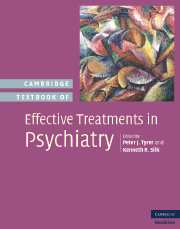Book contents
- Frontmatter
- Contents
- List of contributors
- Preface
- Part I Introduction
- Part II Summary of treatment modalities in psychiatric disorders
- 3 A critical assessment of methods and processes used to develop psychiatric drug treatments
- 4 Section I – The efficacy and safety of electroconvulsive therapy
- 4 Section II – Focal brain stimulation approaches to psychiatric treatment
- 5 The effectiveness of psychological treatments in psychiatry
- 6 Educational interventions
- 7 Complementary and alternative medicine
- 8 Complex interventions
- Part III Specific treatments
- Appendix I Summary of specific drugs having evidence of effectiveness in mental disorders
- Appendix II Key to effectiveness tables
- Index
- References
4 - Section II – Focal brain stimulation approaches to psychiatric treatment
from Part II - Summary of treatment modalities in psychiatric disorders
Published online by Cambridge University Press: 12 May 2010
- Frontmatter
- Contents
- List of contributors
- Preface
- Part I Introduction
- Part II Summary of treatment modalities in psychiatric disorders
- 3 A critical assessment of methods and processes used to develop psychiatric drug treatments
- 4 Section I – The efficacy and safety of electroconvulsive therapy
- 4 Section II – Focal brain stimulation approaches to psychiatric treatment
- 5 The effectiveness of psychological treatments in psychiatry
- 6 Educational interventions
- 7 Complementary and alternative medicine
- 8 Complex interventions
- Part III Specific treatments
- Appendix I Summary of specific drugs having evidence of effectiveness in mental disorders
- Appendix II Key to effectiveness tables
- Index
- References
Summary
Editor's note
This chapter illustrates how fast-growing are effective treatments in psychiatry. Twenty years ago the contents of this chapter would hardly be understood by the average clinician; now each new treatment is hammering on the door of clinical practice demanding to be let in. The most researched treatment is transcranial magnetic stimulation (TMS); this has been shown clearly to have antidepressant efficacy and, although not as effective as ECT in severe depression, has fewer adverse effects. All the other treatments are really at the early stage of clinical experience and are not first-line treatments. Magnetic seizure therapy and vagus nerve stimulation may have a role in treatment-resistant depression and deep brain stimulation (DBS) is likely to replace the various forms of leucotomy still practiced in some parts of the world, mainly because DBS can be controlled and directed so much more specifically than the older treatments. Transcranial direct current stimulation (tDCS) may also have antidepressant effects but more studies are needed. We will all be hearing more about these new treatments which have the potential to replace ECT, leucotomy and related treatments entirely.
Introduction
Advances in the science and technology of neuromodulation over the past two decades have led to several interventions that have rekindled clinical and research interest in nonpharmacological somatic therapies. Although electroconvulsive therapy (ECT) remains the only somatic treatment with widespread acceptance and application based upon 70 years of clinical use, transcranial magnetic stimulation (TMS), magnetic seizure therapy (MST), vagus nerve stimulation (VNS), deep brain stimulation (DBS) and transcranial direct current stimulation (tDCS), all offer novel means of potentially treating neuropsychiatric conditions and may provide a better understanding of the brain pathophysiology of these disorders.
- Type
- Chapter
- Information
- Cambridge Textbook of Effective Treatments in Psychiatry , pp. 83 - 97Publisher: Cambridge University PressPrint publication year: 2008



